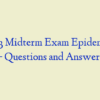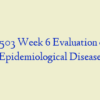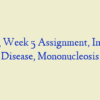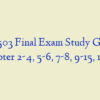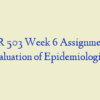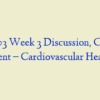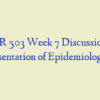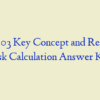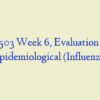Description
NR 503 Final Exam Study Guide
- Which of the following is a condition which may occur during the incubation period?
- The ability of a single person to remain free of clinical illness following exposure to an infectious agent is known as:
- ……characteristic of a single-exposure, common-vehicle outbreak?
- __ diarrhea attack rate in persons who ate both ice cream and pizza?
- What is the overall attack rate in persons who did not eat ice cream?
- … items (or combination of items) is most likely to be the infective item(s)?
- Which of the following reasons can explain why a person who did not consume the infective food item got sick?
- Chicken pox is a highly communicable disease. It may be … by direct contact with a person … with the varicella-zoster virus (VZV). The typical incubation time is between 10 to 20 days. A boy started school 2 weeks after showing symptoms of chicken pox including mild fever, skin rash, and fluid-filled blisters. One month after the boy returned to school, none of his classmates … by VZV. The main reason was:
- An outbreak of gastroenteritis occurred at a boarding school with a student enrollment of 846. Fifty-seven students reported symptoms including vomiting, diarrhea, nausea, and low-grade fever between 10 p.m. on September 24 and 8 p.m. on September 25. The ill students lived in dormitories that housed 723 of the students. The table below provides information on the number of students per type of residence and the number reporting illnesses consistent with the described symptoms and onset time. Calculate the attack rate among all students at the boarding school.
- An outbreak of gastroenteritis occurred at a boarding school with a student enrollment of 846. Fifty-seven students reported symptoms including vomiting, diarrhea, nausea, and low-grade fever between 10 p.m. on September 24 and 8 p.m. on September 25. The ill students lived in dormitories that housed 723 of the students. The table below provides information on the number of students per type of residence and the number reporting illnesses consistent with the described symptoms and onset time. What is the proportion of total cases occurring in boys?
- An outbreak of gastroenteritis occurred at a boarding school with a student enrollment of 846. Fifty-seven students reported symptoms including vomiting, diarrhea, nausea, and low-grade fever between 10 p.m. on September 24 and 8 p.m. on September 25. The ill students lived in dormitories that housed 723 of the students. The table below provides information on the number of students per type of residence and the number reporting illnesses consistent with the described symptoms and onset time. What is the proportion of total cases occurring in students who live in dormitories?
- An outbreak of gastroenteritis occurred at a boarding school with a student enrollment of 846. Fifty-seven students reported symptoms including vomiting, diarrhea, nausea, and low-grade fever between 10 p.m. on September 24 and 8 p.m. on September 25. The ill students lived in dormitories that housed 723 of the students. The table below provides information on the number of students per type of residence and the number reporting illnesses consistent with the described symptoms and onset time. Which proportion is more informative for the purpose of the outbreak investigation?
- An outbreak of gastroenteritis occurred at a boarding school with a student enrollment of 846. Fifty-seven students reported symptoms including vomiting, diarrhea, nausea, and low-grade fever between 10 p.m. on September 24 and 8 p.m. on September 25. The ill students lived in dormitories that housed 723 of the students. The table below provides information on the number of students per type of residence and the number reporting illnesses consistent with the described symptoms and onset time. Calculate the attack rates for boys and girls separately.
- A group of researchers are … in conducting a clinical trial to determine whether a new cholesterol-lowering agent was useful in preventing coronary heart disease (CHD). They identified 12,327 potential participants for the trial. At the initial clinical exam, 309 were … to have CHD. The remaining subjects … the trial and were … equally into the treatment and placebo groups. Of those in the treatment group, 505 developed CHD after 5 years of follow-up while 477 developed CHD during the same period in the placebo group. What was the prevalence of CHD at the initial exam?
- A group of researchers are … in conducting a clinical trial to determine whether a new cholesterol-lowering agent was useful in preventing coronary heart disease (CHD). They identified 12,327 potential participants for the trial. At the initial clinical exam, 309 were … to have CHD. The remaining subjects … the trial and were … equally into the treatment and placebo groups. Of those in the treatment group, 505 developed CHD after 5 years of follow-up while 477 developed CHD during the same period in the placebo group. What was the incidence of CHD during the 5-year study?
- Which of the following are examples of a population prevalence rate?
- What would be the effect on age-specific incidence rates of uterine cancer if women with hysterectomies were … from the denominator of incidence calculations assuming that most women who … hysterectomies are older than 50 years of age.
- among 1,000 … adult males in the United States in 2005. The results from this survey are … The researchers stated that there was a doubling of risk of hypertension in each age group younger than 60 years of age. You conclude that the researchers’ interpretation:
- and prevalence rates of a chronic childhood illness for a specific community are …
- Based on the data, which of the following interpretations best describes disease X?
- A prevalence survey conducted from January 1 through December 31, 2003 identified 580 new cases of tuberculosis in a city of 2 million persons. The incidence rate of tuberculosis in this population has historically been 1 per 4,000 persons each year. What is the incident rate of tuberculosis per 100,000 persons in 2003?
- A prevalence survey conducted from January 1 through December 31, 2003 identified 580 new cases of tuberculosis in a city of 2 million persons. The incidence rate of tuberculosis in this population has historically been 1 per 4,000 persons each year. Has the risk of tuberculosis increased or decreased during 2003?
- Which of the following is an advantage of active surveillance?
- The population of a city on February 15, 2005, was 36,600. The city has a passive surveillance system that collects hospital and private physician reports of influenza cases every month. During the period between January 1 and April 1, 2005, 2,200 new cases of influenza occurred in the city. Of these cases, 775 persons were ill with influenza according to surveillance reports on April 1, 2005. The monthly incidence rate of active cases of influenza for the 3-month period was:
- The population of a city on February 15, 2005, was 36,600. The city has a passive surveillance system that collects hospital and private physician reports of influenza cases every month. During the period between January 1 and April 1, 2005, 2,200 new cases of influenza occurred in the city. Of these cases, 775 persons were ill with influenza according to surveillance reports on April 1, 2005. The prevalence rate of active influenza as of April 1, 2005, was:
- The population of a city on February 15, 2005, was 36,600. The city has a passive surveillance system that collects hospital and private physician reports of influenza cases every month. During the period between January 1 and April 1, 2005, 2,200 new cases of influenza occurred in the city. Of these cases, 775 persons were ill with influenza according to surveillance reports on April 1, 2005. What can … inferred about influenza cases occurring in the city?
- A study found that adults older than age 50 had a higher prevalence of pneumonia than those who were younger than age 50. Which of the following is consistent with this finding?
- Which of the following statements are true? More than one answer may be correct.
- A disease has an incidence of 10 per 1,000 persons per year, and 80% of those affected will die within 1 year. Prior to the year 2000, only 50% of cases of the disease were … by physician … prior to death. In the year 2000, a lab test was … 90% of cases an average of 6 months prior to symptom onset; however, the prognosis did not improve after diagnosis. Comparing the epidemiology of the disease prior to 2000 with the epidemiology of the disease after the development of the lab test, which statement is true concerning the disease in 2000?
- The prevalence rate of a disease is two times greater in women than in men, but the incidence rates are the same in men and women. Which of the following statements may explain this situation?
- A disease has an incidence of 10 per 1,000 persons per year, and 80% of those affected will die within 1 year. Prior to the year 2000, only 50% of cases of the disease were detected by physician diagnosis prior to death. In the year 2000, a lab test was developed that identified 90% of cases an average of 6 months prior to symptom onset; however, the prognosis did not improve after diagnosis. Which statement is true concerning the duration of the disease after the development of the lab test?
- A disease has an incidence of 10 per 1,000 persons per year, and 80% of those affected will die within 1 year. Prior to the year 2000, only 50% of cases of the disease were detected by physician diagnosis prior to death. In the year 2000, a lab test was developed that identified 90% of cases an average of 6 months prior to symptom onset; however, the prognosis did not improve after diagnosis. Which statement is true concerning the disease-specific mortality rate after the development of the lab test?
- In a coastal area of a country in which a tsunami struck, there were 100,000 deaths in a population of 2.4 million for the year ending December 31, 2005. What was the all-cause crude mortality rate per 1,000 persons during 2005?
- In an industrialized nation, there were 192 deaths due to lung diseases in miners ages 20 to 64 years. The expected number of deaths in this occupational group, based on age-specific death rates for lung diseases in all males ages 20 to 64 years, was 238 during 1990. What was the … mortality ratio (SMR) for lung diseases in miners?
- In 2001, a state enacted a law that required the use of safety seats for all children under 7 years of age and mandatory seatbelt use for all persons. The table below lists the number of deaths due to motor vehicle accidents (MVAs) and the total population by age in 2000 (before the law) and in 2005 (4 years after the law was enacted). What is the age-specific mortality rate due to MVAs for children ages 0 to 18 years in 2000?
- In 2001, a state enacted a law that required the use of safety seats for all children under 7 years of age and mandatory seatbelt use for all persons. The table below lists the number of deaths due to motor vehicle accidents (MVAs) and the total population by age in 2000 (before the law) and in 2005 (4 years after the law was enacted).Using the pooled total of the 2000 and 2005 populations as the standard rate, calculate the age-adjusted mortality rate due to MVAs in 2005.
- In 2001, a state enacted a law that required the use of safety seats for all children under 7 years of age and mandatory seatbelt use for all persons. The table below lists the number of deaths due to motor vehicle accidents (MVAs) and the total population by age in 2000 (before the law) and in 2005 (4 years after the law was enacted).Based on the information in the table, it was reported that there was an increased risk of death due to MVAs in the state after the law was passed. These conclusions are:
- The table below describes the number of illnesses and deaths caused by plague in four communities.
- For colorectal cancer diagnosed at an early stage, the disease can have 5-year survival rates of greater than 80%. Which answer best describes early stage colorectal cancer?
- The following table gives the mean annual age-specific mortality rates from measles during the first 25 years of life in successive 5-year periods. You may assume that the population is in a steady state (i.e., migrations out are equal to migrations in). The age-specific mortality rates for the cohort born in 1915-1919 are:
- The following table gives the mean annual age-specific mortality rates from measles during the first 25 years of life in successive 5-year periods. You may assume that the population is in a steady state (i.e., migrations out are equal to migrations in). Based on the information above, one may conclude:
- Which of the following characteristics indicate that mortality rates provide a reliable estimate of disease incidence? More than one answer may be correct.
- Which of the following statements are true? More than one answer may be correct.
- Among those who are 25 years of age, those who have been driving less than 5 years had 13,700 motor vehicle accidents in 1 year, while those who had been driving for more than 5 years had 21,680 motor vehicle accidents during the same time period. It was concluded from these data that 25-year-olds with more driving experience have increased accidents compared to those who started driving later. This conclusion is:
- For a disease such as liver cancer, which is highly fatal and of short duration, which of the following statements is true? Choose the best answer.
- The case-fatality rate associated with plague is lowest in which community?
- The table below describes the number of illnesses and deaths caused by plague in four communities. The proportionate mortality ratio associated with plague is lowest in which community?













